Kaitlyn Zhou
Rethinking Word Similarity: Semantic Similarity through Classification Confusion
Feb 08, 2025Abstract:Word similarity has many applications to social science and cultural analytics tasks like measuring meaning change over time and making sense of contested terms. Yet traditional similarity methods based on cosine similarity between word embeddings cannot capture the context-dependent, asymmetrical, polysemous nature of semantic similarity. We propose a new measure of similarity, Word Confusion, that reframes semantic similarity in terms of feature-based classification confusion. Word Confusion is inspired by Tversky's suggestion that similarity features be chosen dynamically. Here we train a classifier to map contextual embeddings to word identities and use the classifier confusion (the probability of choosing a confounding word c instead of the correct target word t) as a measure of the similarity of c and t. The set of potential confounding words acts as the chosen features. Our method is comparable to cosine similarity in matching human similarity judgments across several datasets (MEN, WirdSim353, and SimLex), and can measure similarity using predetermined features of interest. We demonstrate our model's ability to make use of dynamic features by applying it to test a hypothesis about changes in the 18th C. meaning of the French word "revolution" from popular to state action during the French Revolution. We hope this reimagining of semantic similarity will inspire the development of new tools that better capture the multi-faceted and dynamic nature of language, advancing the fields of computational social science and cultural analytics and beyond.
Rel-A.I.: An Interaction-Centered Approach To Measuring Human-LM Reliance
Jul 10, 2024Abstract:The reconfiguration of human-LM interactions from simple sentence completions to complex, multi-domain, humanlike engagements necessitates new methodologies to understand how humans choose to rely on LMs. In our work, we contend that reliance is influenced by numerous factors within the interactional context of a generation, a departure from prior work that used verbalized confidence (e.g., "I'm certain the answer is...") as the key determinant of reliance. Here, we introduce Rel-A.I., an in situ, system-level evaluation approach to measure human reliance on LM-generated epistemic markers (e.g., "I think it's..", "Undoubtedly it's..."). Using this methodology, we measure reliance rates in three emergent human-LM interaction settings: long-term interactions, anthropomorphic generations, and variable subject matter. Our findings reveal that reliance is not solely based on verbalized confidence but is significantly affected by other features of the interaction context. Prior interactions, anthropomorphic cues, and subject domain all contribute to reliance variability. An expression such as, "I'm pretty sure it's...", can vary up to 20% in reliance frequency depending on its interactional context. Our work underscores the importance of context in understanding human reliance and offers future designers and researchers with a methodology to conduct such measurements.
Relying on the Unreliable: The Impact of Language Models' Reluctance to Express Uncertainty
Jan 12, 2024Abstract:As natural language becomes the default interface for human-AI interaction, there is a critical need for LMs to appropriately communicate uncertainties in downstream applications. In this work, we investigate how LMs incorporate confidence about their responses via natural language and how downstream users behave in response to LM-articulated uncertainties. We examine publicly deployed models and find that LMs are unable to express uncertainties when answering questions even when they produce incorrect responses. LMs can be explicitly prompted to express confidences, but tend to be overconfident, resulting in high error rates (on average 47%) among confident responses. We test the risks of LM overconfidence by running human experiments and show that users rely heavily on LM generations, whether or not they are marked by certainty. Lastly, we investigate the preference-annotated datasets used in RLHF alignment and find that humans have a bias against texts with uncertainty. Our work highlights a new set of safety harms facing human-LM interactions and proposes design recommendations and mitigating strategies moving forward.
Navigating the Grey Area: Expressions of Overconfidence and Uncertainty in Language Models
Feb 26, 2023Abstract:Despite increasingly fluent, relevant, and coherent language generation, major gaps remain between how humans and machines use language. We argue that a key dimension that is missing from our understanding of language models (LMs) is the model's ability to interpret and generate expressions of uncertainty. Whether it be the weatherperson announcing a chance of rain or a doctor giving a diagnosis, information is often not black-and-white and expressions of uncertainty provide nuance to support human-decision making. The increasing deployment of LMs in the wild motivates us to investigate whether LMs are capable of interpreting expressions of uncertainty and how LMs' behaviors change when learning to emit their own expressions of uncertainty. When injecting expressions of uncertainty into prompts (e.g., "I think the answer is..."), we discover that GPT3's generations vary upwards of 80% in accuracy based on the expression used. We analyze the linguistic characteristics of these expressions and find a drop in accuracy when naturalistic expressions of certainty are present. We find similar effects when teaching models to emit their own expressions of uncertainty, where model calibration suffers when teaching models to emit certainty rather than uncertainty. Together, these results highlight the challenges of building LMs that interpret and generate trustworthy expressions of uncertainty.
Deconstructing NLG Evaluation: Evaluation Practices, Assumptions, and Their Implications
May 13, 2022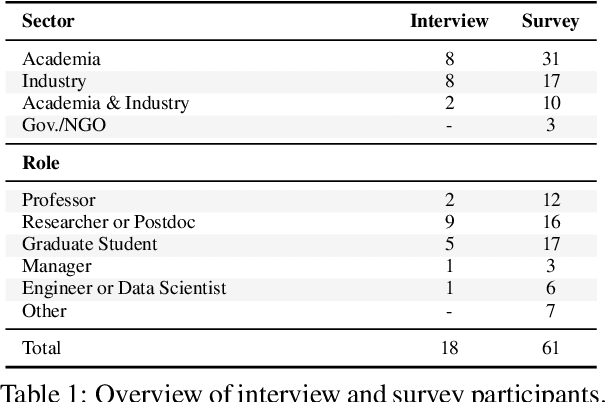
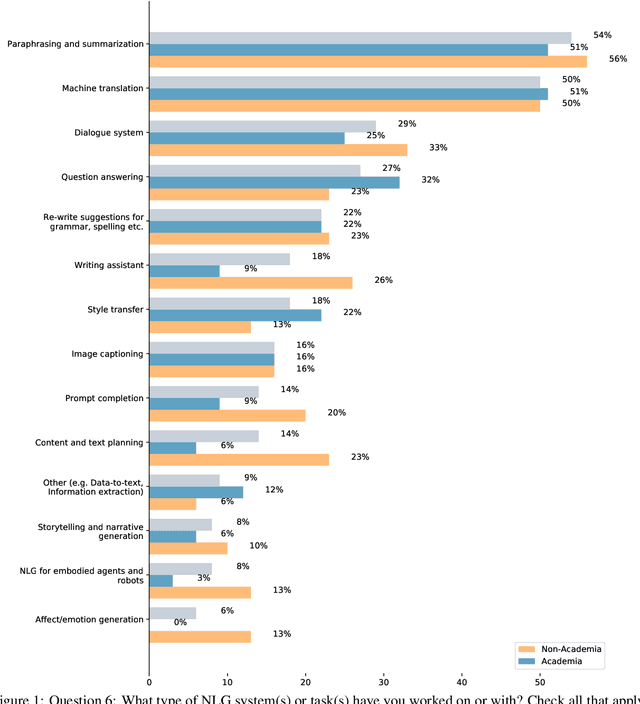
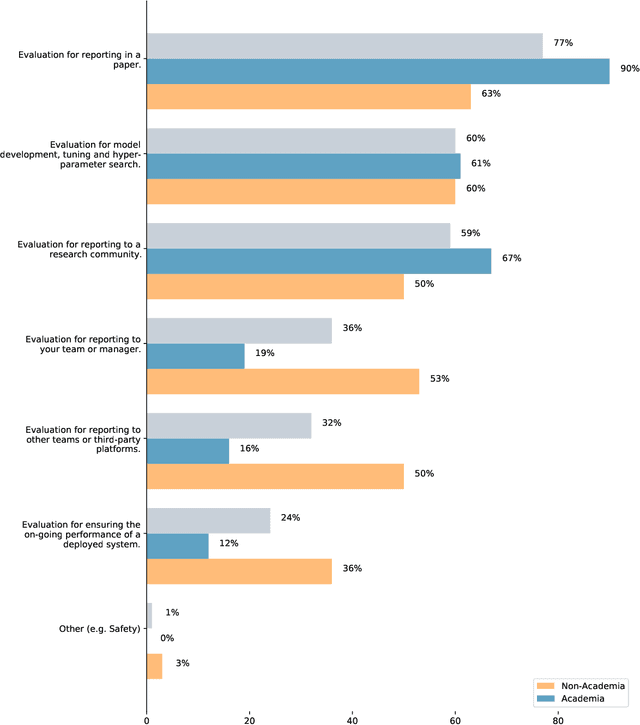
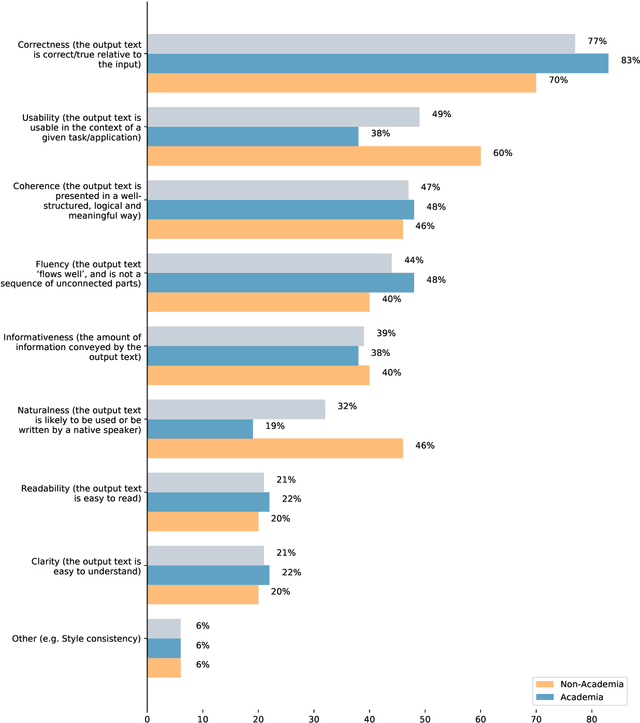
Abstract:There are many ways to express similar things in text, which makes evaluating natural language generation (NLG) systems difficult. Compounding this difficulty is the need to assess varying quality criteria depending on the deployment setting. While the landscape of NLG evaluation has been well-mapped, practitioners' goals, assumptions, and constraints -- which inform decisions about what, when, and how to evaluate -- are often partially or implicitly stated, or not stated at all. Combining a formative semi-structured interview study of NLG practitioners (N=18) with a survey study of a broader sample of practitioners (N=61), we surface goals, community practices, assumptions, and constraints that shape NLG evaluations, examining their implications and how they embody ethical considerations.
Richer Countries and Richer Representations
May 10, 2022



Abstract:We examine whether some countries are more richly represented in embedding space than others. We find that countries whose names occur with low frequency in training corpora are more likely to be tokenized into subwords, are less semantically distinct in embedding space, and are less likely to be correctly predicted: e.g., Ghana (the correct answer and in-vocabulary) is not predicted for, "The country producing the most cocoa is [MASK].". Although these performance discrepancies and representational harms are due to frequency, we find that frequency is highly correlated with a country's GDP; thus perpetuating historic power and wealth inequalities. We analyze the effectiveness of mitigation strategies; recommend that researchers report training word frequencies; and recommend future work for the community to define and design representational guarantees.
Problems with Cosine as a Measure of Embedding Similarity for High Frequency Words
May 10, 2022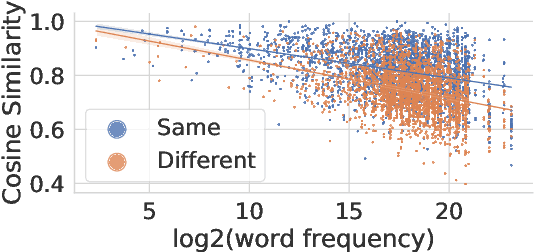

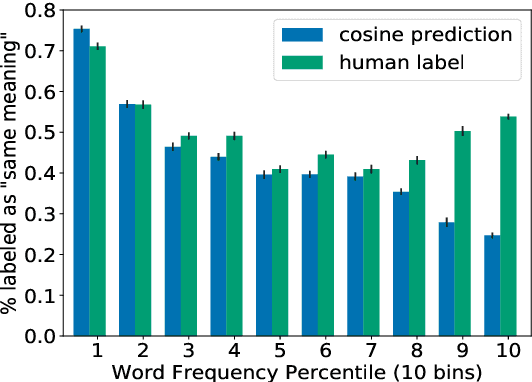

Abstract:Cosine similarity of contextual embeddings is used in many NLP tasks (e.g., QA, IR, MT) and metrics (e.g., BERTScore). Here, we uncover systematic ways in which word similarities estimated by cosine over BERT embeddings are understated and trace this effect to training data frequency. We find that relative to human judgements, cosine similarity underestimates the similarity of frequent words with other instances of the same word or other words across contexts, even after controlling for polysemy and other factors. We conjecture that this underestimation of similarity for high frequency words is due to differences in the representational geometry of high and low frequency words and provide a formal argument for the two-dimensional case.
On the Opportunities and Risks of Foundation Models
Aug 18, 2021
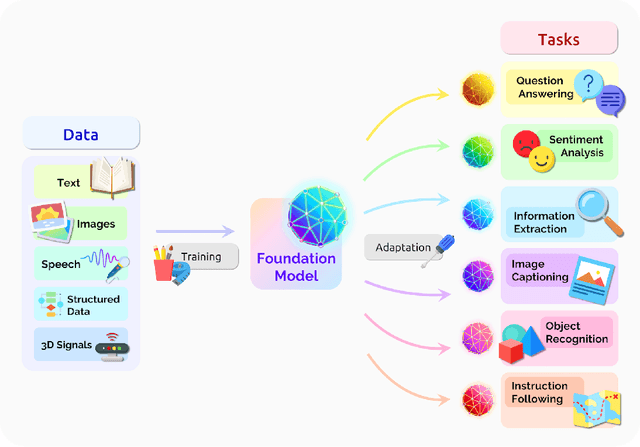
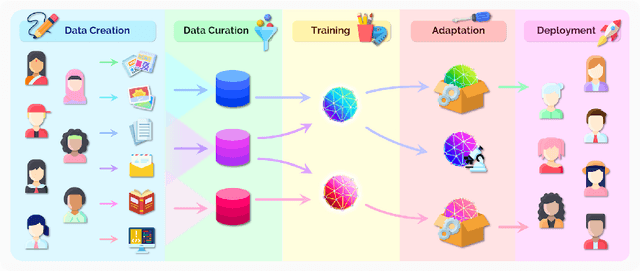
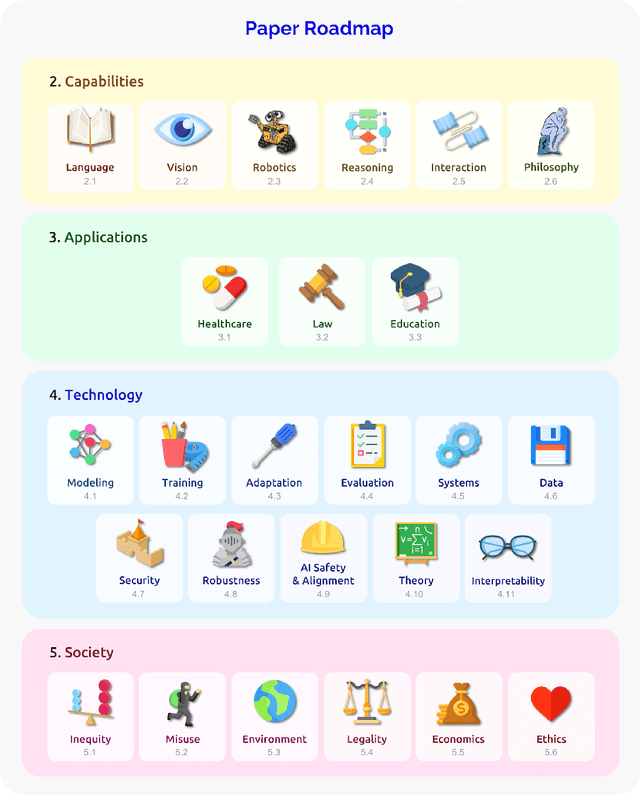
Abstract:AI is undergoing a paradigm shift with the rise of models (e.g., BERT, DALL-E, GPT-3) that are trained on broad data at scale and are adaptable to a wide range of downstream tasks. We call these models foundation models to underscore their critically central yet incomplete character. This report provides a thorough account of the opportunities and risks of foundation models, ranging from their capabilities (e.g., language, vision, robotics, reasoning, human interaction) and technical principles(e.g., model architectures, training procedures, data, systems, security, evaluation, theory) to their applications (e.g., law, healthcare, education) and societal impact (e.g., inequity, misuse, economic and environmental impact, legal and ethical considerations). Though foundation models are based on standard deep learning and transfer learning, their scale results in new emergent capabilities,and their effectiveness across so many tasks incentivizes homogenization. Homogenization provides powerful leverage but demands caution, as the defects of the foundation model are inherited by all the adapted models downstream. Despite the impending widespread deployment of foundation models, we currently lack a clear understanding of how they work, when they fail, and what they are even capable of due to their emergent properties. To tackle these questions, we believe much of the critical research on foundation models will require deep interdisciplinary collaboration commensurate with their fundamentally sociotechnical nature.
Frequency-based Distortions in Contextualized Word Embeddings
Apr 17, 2021



Abstract:How does word frequency in pre-training data affect the behavior of similarity metrics in contextualized BERT embeddings? Are there systematic ways in which some word relationships are exaggerated or understated? In this work, we explore the geometric characteristics of contextualized word embeddings with two novel tools: (1) an identity probe that predicts the identity of a word using its embedding; (2) the minimal bounding sphere for a word's contextualized representations. Our results reveal that words of high and low frequency differ significantly with respect to their representational geometry. Such differences introduce distortions: when compared to human judgments, point estimates of embedding similarity (e.g., cosine similarity) can over- or under-estimate the semantic similarity of two words, depending on the frequency of those words in the training data. This has downstream societal implications: BERT-Base has more trouble differentiating between South American and African countries than North American and European ones. We find that these distortions persist when using BERT-Multilingual, suggesting that they cannot be easily fixed with additional data, which in turn introduces new distortions.
 Add to Chrome
Add to Chrome Add to Firefox
Add to Firefox Add to Edge
Add to Edge